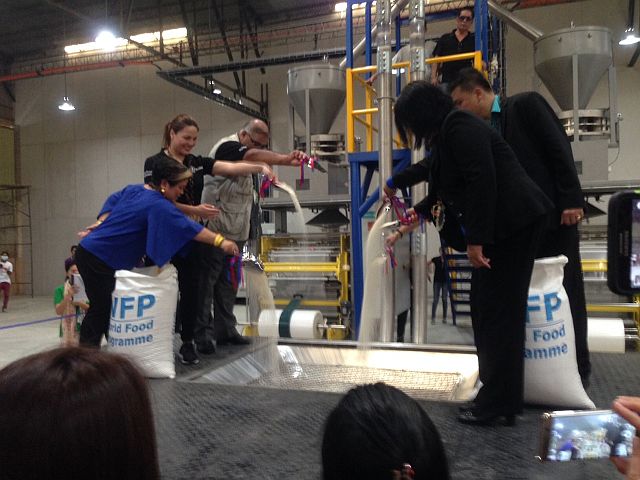
social Welfare Secretary Dinky Soliman leads the ceremonial pouring of rice on the automatic bagging machine during the inauguration of the Visayas Disaster Response Center. (CDN PHOTO/CARMEL LOISE MATUS)
A regional hub for its relief operations was inaugurated yesterday morning by the Department of Social Welfare and Development (DSWD) together with the World Food Program (WFP) Philippines.
The Visayas Disaster Response Center located in Barangay Casuntingan, Mandaue City is among the three key response areas in the country identified by the DSWD and WFP to serve as hub for packing relief goods.
Social Welfare Secretary Corazon “Dinky” Soliman led the ribbon-cutting together with Praveen Agrawal, WFP Philippines country director, and Kristina Cassandra “KC” Concepcion, UN-WFP National Ambassador Against Hunger.
This $1.2 million project is part of the US $10 million project funded by Australian Aid and the UK Aid.
In a press conference yesterday after the walkthrough, Agrawal said they chose Cebu as the area because of its strategic location in the Visayas.
He added that the WFP Philippines, which serves as the custodian, oversees the packing operations.
The DSWD, for its part, provides manpower through their 4Ps beneficiaries. These beneficiaries, according to Soliman, can work either as volunteers or under the DSWD’s cash for work program.
The 5,000-square-meter center is equipped with an automatic bagging machine which repacks six kilos of rice.
This mechanized production system, according to Soliman, helps pack at least 250,000 relief packs a day.
Actress KC Concepcion, in her message, said this technology is a blessing.
She shared her experience in participating in the packing of relief goods where she said volunteers could hardly meet the number of relief packs needed by the disaster victims.
Agrawal said the mechanized system would be used should the “inevitable need arise” during a major calamity.
“Would we be able to respond faster, quicker and save lives? The ultimate goal is to saving lives,” he said when he delivered his message.
This is the second disaster response center established in the country. The first one was established in Pasay — the National Resource Centre.
Both centers have the combined capacity to produce 500,000 relief packs in a day.
The media was invited to the walkthrough of the facility.
From the rice bagging area, the automatic bagging machine can pack six kilos of rice.
The repacked rice will be placed in the box together with four cans of sardines, four cans of beef loaf, and six sachets of coffee.
Each relief pack is good for three days.
There are also people who will ensure that expiry dates are indicated on the boxes.
The $1.2 million cost for the project includes the $200,000 rental of the warehouse for one year, machinery, renovation, training, electronics, and capacity building of the people.
Aside from the mechanized production system, the center also has pallet racking system for improved storage of food packs and warehousing of food and non-food commodities.
Other key areas where similar centers will be established are General Santos City and Clark.
Soliman indicated that it is only in Cebu where they have rented the area.
In Pasay, she said the lot is owned by the DSWD while the lot in General Santos City is owned by Civil Aviation Authority of the Philippines (CAAP) and the lot in Clark is being leased to them for free by the Bases Conversion and Development Authority.
Aside from this, Soliman said each regional office of DSWD has 30,000 prepositioned relief packs ready for deployment in case it will be needed.